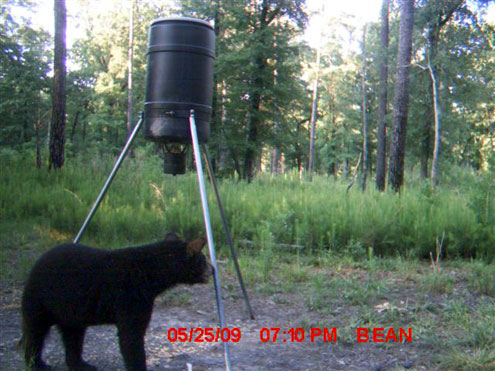
As recently as June 21 of this year, there is documentation of a bear around the corn feeder of Chris Bean from Paris, Tx. Chris says in late May he filled his feeder with corn and set his trail camera nearby. When he returned a month or so later to check the camera, in hopes of seeing some big bucks with heavy antlers in velvet, he was shocked to see the image of a black bear.
“I did a double take when I looked over the pictures from the camera," says Bean. "I expected to see deer and hogs but certainly not what appeared to be an almost grown black bear!”
Timmy Romine, who manages the hunting on the Circle T Bowhunting Ranch near Commerce has a hunting lease in northern Red River county. Year before last, he was checking his trail camera, also set beside his corn feeder, and the head of a big black bear was captured on film!
“I showed the picture to everyone I knew and a few weeks later another hunter captured the image of a standing bear beside his feeder," Romine recalled. "We did not see the bear or signs of him last hunting season, but it’s a good bet where there is one bear, there should be more.”
Texas Parks and Wildlife Biologist Regan White says DNA samples from one of the bears identifies it as being a sub-adult male standing about 30 inches high at the shoulders, 5’4” tall and weighing over 200 pounds.
“I am busy attempting to get a hair sample around Bean’s corn feeder," White remarked. "With a DNA sample taken from the hair, we can determine if the bear is of the Louisiana subspecies of black bear, obviously from Louisiana, or and American Black Bear that has moved down from Arkansas or possibly southeast Oklahoma."

Several years ago, the Louisiana subspecies of black bear was stocked in an area in central Louisiana, in hopes of establishing a sustaining population. Female bear with small cubs were released because the biologists hoped that since the babies were too small to travel, the mothers would remain in the area. This stocking went very well and a thriving population of bear was established in that section of the state.
According to White, male black bears appear to be rovers that have the habit of leaving the area where they were raised and seeking out a home area of their own, usually just before coming of breeding age. This appears to be the case with the isolated bear sighting in Red River County. It will be interesting to see the results of the hair sample of the bear that has taken a liking to Bean’s corn feeder. White says DNA samples, when and if a hair sample is obtained, will identify the bear as an American Black Bear or one of the Louisiana sub species. Of course, it will also verify the sex of the bear, which in all probability, will be male.
Chances appear to be pretty good that because of the relatively close proximity to Arkansas, where there is a well established black bear population, the bears caught on camera in Red River County probably crossed the Red River and found cover and food to their liking in the woodlands of northeast Texas.
If all goes well and the bears manage to once again reclaim their previously occupied areas in eastern Texas we will one day have a huntable number. Their numbers certainly bounded back in Arkansas and parts of Louisiana, thanks to good management practices and cooperation between the state wildlife agencies and private landowners.
The huge success of the restocking of the eastern wild turkey in East Texas comes to mind. If good management practices can restore these birds to their native woods and fields, surely an animal as hardy as a black bear can be reintroduced. But, at present, there is no restocking of bears in Texas and in the foreseeable future, no plans to begin a restocking program. Hopefully, more of these male bears will take a liking to the Lone Star State and just maybe a few of their girlfriends will tag along on the voyage across the mighty Red River. One thing is for sure, we’ll have our trail cameras running to capture their arrival on film!
OUTDOOR TIP OF THE WEEK- Crappie have moved out of the shallows into deep water and savvy fishermen are using submerged brush piles to concentrate them. Willows make excellent crappie attractors but only when anchored firmly with weighs such as concrete blocks. Plastic gallon jugs tied securely to the tops of the willows insure they remain in a vertical position, once placed in the water. Make sure and check the local regulations on the body of water you fish about creating these ‘crappie attractors’. I’ve recently set a couple of these crappie magnets on some private waters I fish, which is relatively barren of structure. It seems every crappie in the lake has been attracted to the baitfish that seek shelter around the leaves and branches.
Listen to OUTDOORS WITH LUKE CLAYTON RADIO at www.catfishradio.com